#Automotive Gear Forging
Explore tagged Tumblr posts
Text
We specialize in forged pinion manufacturing, delivering robust, high-performance components vital for heavy machinery, automotive, and industrial gear systems.
#Forged Gear and Pinion Assemblies#advanced gear forging#bevel gear specialists#curvic gear experts#leather gear#precision curvic couplings#precision machined gears#custom heavy-duty gears#gear#automotive gear forging
0 notes
Text
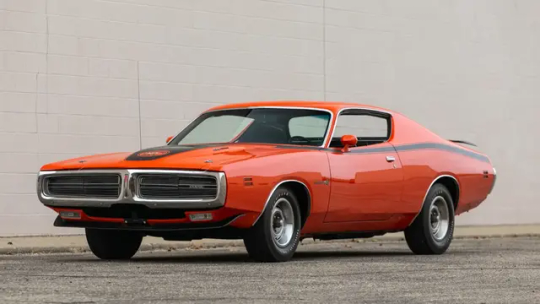
1971 Dodge Hemi Super Bee
The Ultimate Muscle Car of its Time
When it comes to legendary American muscle cars, the 1971 Dodge Hemi Super Bee stands out as an iconic symbol of power, speed, and style. Despite the challenges faced by the performance era during that time, this rare gem emerged as one of the most exceptional vehicles of its generation. In this article, we delve into the remarkable features and unique attributes that make the 1971 Dodge Hemi Super Bee a prized possession for muscle car enthusiasts.
Rarity and Authenticity
In the realm of automotive rarities, the 1971 Dodge Hemi Super Bee holds a special place. Among the limited production numbers, this particular model is one of only nine factory 4-speed Hemi Super Bees manufactured in 1971. What further adds to its allure is the fact that it was sold new through Mr. Norm’s Grand Spaulding Dodge franchise in Chicago. Documentation is key to verifying its authenticity, and this Super Bee comes with an extensive array of records, including the window sticker, invoice, retail order form, Bill of Sale, shipping document, and record envelope. This comprehensive documentation adds an extra layer of credibility to the vehicle’s rich history.

1971 Dodge Hemi Super Bee
Unparalleled Options and Performance
As one of the most highly optioned 1971 Hemi Super Bees known to exist, this Dodge masterpiece offers an array of features that elevate its status to a league of its own. Let’s explore some of the standout elements that define its exceptional performance:
Engine and Transmission
At the heart of this Super Bee lies the mighty matching-numbers 426 Hemi V-8 engine. Equipped with dual 4-barrel carburetors and hemispherical cylinder heads, this powerplant delivers raw power and exhilarating acceleration. What sets Chrysler apart from its competitors is its unwavering commitment to performance, as evidenced by the unchanged 10.25 compression, forged internals, and the adoption of a hydraulic camshaft. Paired with the A34 Super Track Pak, which includes the 18-spline Hemi A833 4-speed manual transmission and a 4.10-geared Sure-Grip Dana 60 differential, this Super Bee offers an unrivaled driving experience.

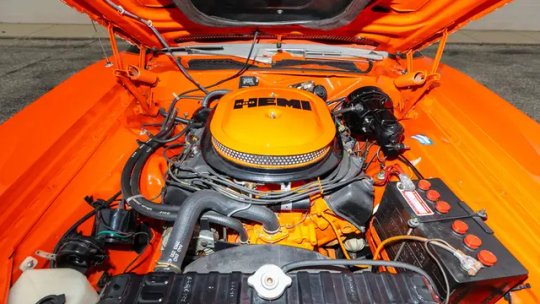
1971 Dodge Hemi Super Bee
Braking and Cooling
Safety and reliability are paramount in any high-performance vehicle, and the 1971 Dodge Hemi Super Bee doesn’t disappoint. It features power brakes with front discs, ensuring quick and efficient stopping power when needed. Additionally, the car is equipped with extreme cooling equipment, a vital component for optimal performance during intense driving conditions.
Exterior and Interior Styling
The exterior of the 1971 Dodge Hemi Super Bee is a sight to behold. Adorned in EV2 Hemi Orange with striking black striping, it exudes an aura of power and aggression. The premium optional concealed headlamps add a touch of refinement to its overall appearance. Other notable exterior elements include hood pins, color-keyed racing mirrors, and front and rear spoilers, accentuating its muscular and aerodynamic design.

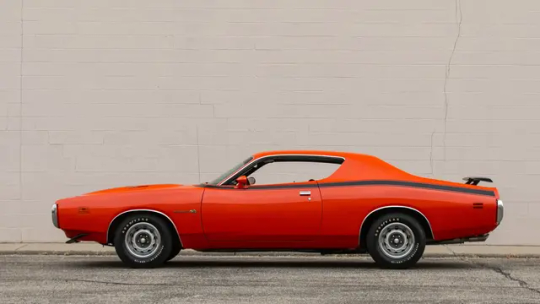
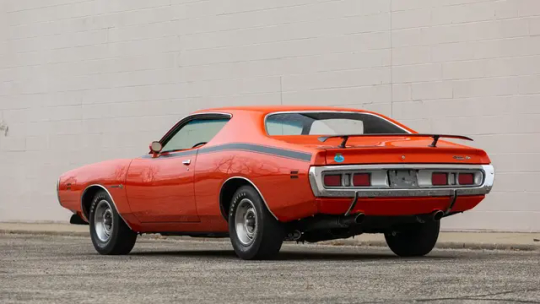
1971 Dodge Hemi Super Bee
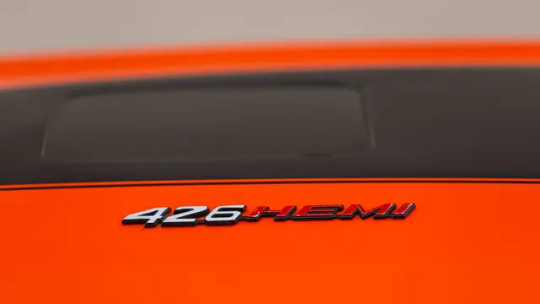
1971 Dodge Hemi Super Bee
Inside the cabin, the Super Bee offers a comfortable and stylish environment. The black vinyl bench seat interior provides a classic and timeless look, while the Hurst Pistol Grip shifter adds a touch of sportiness. The car is also equipped with a pushbutton Multi-Plex AM/FM radio, a Rallye dash cluster with a tachometer, and woodgrain-style trim, all contributing to an enhanced driving experience.
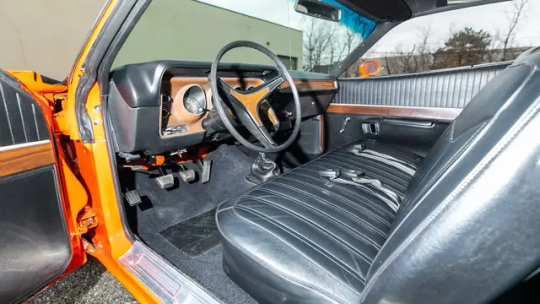
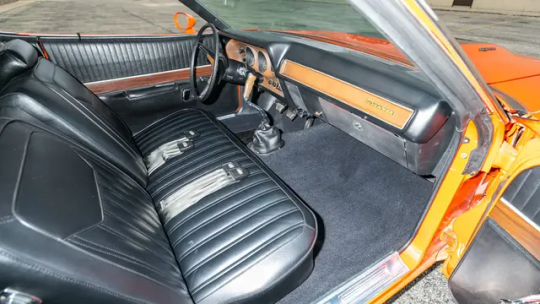
Wheels and Tires
Completing the Super Bee’s striking aesthetics are the premium Rallye wheels and Goodyear G60-15 Polyglas GT tires. These wheels not only enhance the car’s appearance but also provide excellent traction and handling capabilities, ensuring an exhilarating ride on the road.
Conclusion
In the realm of American muscle cars, the 1971 Dodge Hemi Super Bee holds a special place. Its rarity, authenticity, and exceptional performance make it a highly sought-after collector’s item. As the only year that the ‘Bee was built on the Charger platform, this Super Bee stands as a testament to Dodge’s commitment to creating top-of-the-line vehicles that capture the spirit of the muscle car era. Whether you’re a die-hard enthusiast or simply appreciate automotive excellence, the 1971 Dodge Hemi Super Bee is a masterpiece that continues to inspire and captivate generations of car enthusiasts.
#Dodge Hemi Super Bee#Dodge Super Bee#Dodge Hemi#Dodge#Hemi#Super Bee#car#cars#muscle car#american muscle#mopar#moparperformance#moparnation#moparworld
86 notes
·
View notes
Text
Industry Insights: Where We Supply Tool Steel - Virat Special Steels
Virat Special Steels stands tall as India’s largest stockiest, importer, and supplier of HSS Steel, Hot Work Steel, Cold Work Steel & Plastic Mould Steel. Representing top manufacturers of special steels worldwide, we enjoy global recognition for our unwavering commitment to quality.
Serving Industries: 🔧 Forging Industry: Shaping metal using compressive forces with a hammer or press, classified into cold forging, warm forging, or hot forging.
🏗️ Pressure Die Casting: Forcing molten metal under high pressure into a mold cavity, made using two hardened tool steel dies.
🚗 Aluminum Extrusions: Material pushed through a die to the desired cross-section, creating complex parts with excellent surface finishes.
🚙 Automotive Industry: Involved in manufacturing, design, and development of motor vehicles.
⛽ Oil & Gas Industry: Supplying more than 60% of our nation’s energy, including natural gas for electricity.
🧩 Plastic Industry: Manufacturing polymer materials for aerospace, construction, electronics, packaging, and transportation.
🍶 Glass Industry: Involves float glass process and glassblowing, producing sheet glass and containers.
🚲 Cycle Parts: Manufacturing components like bearings, chains, chain sets & cranks, handlebars, forks.
🚉 Railways: Manufacturing railway components such as gear holders, bogie cast parts, axles, pins, ground lever frames, adjustable cranks, compressor pistons, and bearings.
VIRAT SPECIAL STEELS PVT. LIMITED , INDIA is your trusted partner, supplying premium tool steels to diverse industries in India and globally.
Virat Special Steels, INDIA! https://www.viratsteels.com/
📞 Contact us today to learn more about how we can support your business! https://www.viratsteel.in/special-steel-supply-networks/
Any further queries feel free to contact us : 🌐https://www.viratsteels.com/ 📬 [email protected] ☎+91 98140-21775
#ludhiana#viratsteels#india#gurgaon#viratspecialsteels#toolsteelsupplier#gurugram#pune#iso9001#steel#db6 steel#h13diesteel#h13steel#h13steelbarexporter#h11steel#din 2714#din 2344#din2343#din2738#d2steel#m2steels#m35#p20ni
3 notes
·
View notes
Text
Bogie Hearth Furnace – A Heavy-Duty Solution for Heat Treatment Excellence
In industries where large and heavy components require uniform heating and precise temperature control, the bogie hearth furnace stands out as an indispensable solution. From forging shops to automotive part manufacturers, bogie hearth furnaces play a vital role in heat treatment processes such as annealing, normalizing, hardening, and tempering. Their robust design and high loading capacity make them ideal for a wide range of industrial applications.
As one of the leading manufacturers of industrial furnaces in India, JR Furnace & Ovens offers top-of-the-line bogie hearth furnaces tailored to meet the demanding requirements of modern industries.
What is a Bogie Hearth Furnace?
A bogie hearth furnace is a type of batch-type heat treatment furnace designed with a movable hearth or trolley (commonly known as a “bogie”) that can be loaded outside the furnace chamber. Once loaded with workpieces, the bogie is moved into the furnace chamber and sealed for the heat treatment cycle. This feature makes the furnace ideal for handling large or heavy loads efficiently.
Key Features of a Bogie Hearth Furnace:
Heavy-duty construction for long-term durability
Movable hearth (bogie) for convenient loading and unloading
Uniform heat distribution for consistent results
Customizable temperature range (up to 1300°C and beyond)
Available in gas-fired or electrically heated options
PLC-based automation and control system
Advanced insulation for reduced heat loss and energy savings
JR Furnace designs bogie hearth furnaces with the latest insulation materials and energy-efficient heating systems to minimize fuel consumption while maximizing thermal performance.
Applications of Bogie Hearth Furnaces
These furnaces are versatile and suitable for a wide variety of industrial applications. Common uses include:
Annealing of steel and alloy parts
Stress relieving of welded structures
Hardening of large gears and shafts
Normalizing of castings and forgings
Tempering of hardened components
Preheating for forging operations
Due to their high load-carrying capacity and uniform heating, bogie hearth furnaces are preferred in automotive, aerospace, steel, defense, and heavy machinery manufacturing sectors.
Why Choose JR Furnace’s Bogie Hearth Furnaces?
JR Furnace & Ovens is a pioneer in the design and production of custom-engineered heat treatment systems in India. Our bogie hearth furnaces are known for:
Robust Engineering: Made with high-quality refractory lining and heavy-duty steel construction.
Customization Options: Built to suit your component size, weight, and specific process requirements.
Energy Efficiency: Equipped with efficient burners or heating elements and intelligent controls.
After-Sales Support: Comprehensive support and AMC options to ensure long-term performance.
Proven Track Record: Trusted by leading manufacturers across automotive, steel, and aerospace industries.
We understand that every manufacturing process is unique. That’s why we work closely with clients to design bogie hearth furnaces that deliver both performance and value.
Advantages at a Glance:
Ideal for large/heavy components
Easy loading and unloading using the movable hearth
Flexible temperature settings for various heat treatment needs
Optional protective atmosphere system for oxidation control
Long service life with minimal maintenance
With features like these, the bogie hearth furnace proves to be a smart investment for companies aiming for consistent quality and efficient processing.
Conclusion
A bogie hearth furnace is more than just a heat treatment solution—it's a workhorse that ensures precision, reliability, and productivity in every cycle. Whether you are processing steel forgings, aerospace components, or large machine parts, this type of furnace provides the durability and flexibility your operation demands.
At JR Furnace & Ovens, we are committed to delivering world-class heat treatment solutions that empower manufacturers to excel. If you are looking to invest in a bogie hearth furnace built for lasting performance, talk to our team today.
0 notes
Text
Volk TE 37 Watch – A Timepiece That Speaks to Tuners and Track Warriors
An Automotive Icon Turned Wristwear
For many car lovers, the name Volk TE 37 immediately sparks a memory—perhaps it’s the sound of a tuned exhaust on the track or the gleam of a clean six-spoke wheel at a car show. Known for its light weight, toughness, and unique design, the TE 37 rim is one of the most beloved wheels in the car world.
Now, imagine taking that legacy and turning it into something you can wear every day. That’s exactly what the Volk TE 37 watch does. Crafted by HMN Watch, this piece brings automotive design and lifestyle together in one powerful accessory.
Built to Reflect Power and Precision
Just like the original wheel, the Volk TE 37 watch is built with high-quality materials and meticulous attention to detail. The face of the watch mirrors the wheel’s six-spoke pattern, symbolizing speed and strength. It’s the perfect fusion of motorsport engineering and fashion.

The watch’s body is made from lightweight yet durable materials, just like the forged aluminum used in the real TE 37 rims. The dial offers subtle but striking finishes, often inspired by classic rim colors like matte black, bronze, and gunmetal. Whether you're at a meet or in a meeting, this watch always adds style and substance.
Everyday Style with Track-Ready Toughness
What makes the Volk TE 37 watch truly special is how well it fits into your daily life. It's not just made for car shows—it’s tough enough for your workday, stylish enough for a night out, and functional enough for your road trips. Water-resistant, scratch-proof, and shock-absorbing, this watch can handle whatever the day throws at it.
Pair it with your favorite streetwear or your cleanest fit for weekend drives. The watch is flexible and designed to look good with almost anything—whether you're in racing gear or casual clothes.
A Watch That Represents Passion
Wearing the Volk TE 37 watch is about more than just telling time. It’s about telling the world what drives you. It’s for those who can’t go a day without thinking about tuning, torque, and track days. It’s for those who appreciate craftsmanship, heritage, and performance.
Whether you’re a JDM lover, Euro car fan, or American muscle enthusiast, this watch speaks to a shared culture—a love of everything on four wheels. And now, that love can live on your wrist every day.
Get Yours from HMN Watch Today
HMN Watch has created the Volk TE 37 watch with car culture in mind. It’s more than a timepiece—it’s part of your identity. Whether you're buying it for yourself or gifting it to a fellow car fanatic, this is a watch that carries meaning.
Visit HMN Watch today to get your own Volk TE 37 watch and wear your passion with pride.
0 notes
Text
How to Choose the Best Electric Motor Coil and Metal Forging Company for Your Manufacturing Needs
Introduction
In today’s manufacturing world, precision is everything. Whether you're producing EV motors, aerospace parts, or heavy industrial equipment, you need reliable components that perform under pressure. That’s where Electric Motor Coil Companies and Metal Forging Companies step in—serving as the backbone of modern mechanical systems.
Let’s explore what makes a top-tier electric motor coil and metal forging company and how to choose the best one for your business.
Understanding Electric Motor Coil Companies
Electric motor coils are essential parts of motors, transformers, and generators. These coils are made of insulated copper or aluminum wires wound into a specific pattern to create magnetic fields. A dedicated Electric Motor Coil Company specializes in designing and manufacturing these coils to meet the demands of various industries.
From electric vehicles to industrial machinery, motor coils are everywhere. Getting them right means ensuring smooth, efficient performance.
What Makes a Great Electric Motor Coil Company?
Not all coils are created equal. A top-tier Electric Motor Coil Company focuses on:
High-Quality Conductors: Pure copper or aluminum for minimal resistance.
Precision Winding: Computer-controlled winding for uniformity and efficiency.
Durability: Excellent insulation and heat resistance.
Certifications: ISO, UL, or CE certifications that ensure international compliance.
Signs of a Trusted Coil Manufacturer
Before selecting a company, look for:
Experience in High-Performance Markets: Like aerospace, defense, or EVs.
Custom Coil Designs: For unique voltage, amperage, or thermal requirements.
Strong R&D Department: Innovation in insulation, winding, and cooling techniques.
Positive Reviews & Long-Term Clients: A sure sign of reliability.
Overview of a Metal Forging Company
Forging is a manufacturing process where metal is compressed under high pressure to form durable shapes. A Metal Forging Company delivers critical parts like gears, shafts, flanges, and connecting rods that are essential to engine and machine performance.
There are two main forging techniques:
Hot Forging: For soft, ductile results in high-temperature settings.
Cold Forging: For better surface finish and tighter tolerances.
Characteristics of a Reliable Metal Forging Company
A top-level forging company brings the following:
Versatility in Materials: Steel, aluminum, brass, and exotic alloys.
Precision Dies and Molds: CNC-made tools for tight tolerances.
Post-Processing Capabilities: Including heat treatment, machining, and inspection.
Repeatability: Consistent results across thousands of units.
Industries that Rely on Forged Parts
Forged components are used across:
Automotive Engines & Drivetrains
Aerospace Landing Gears
Oil & Gas Drilling Equipment
Construction Machinery
Without high-quality forged parts, these industries would come to a halt.
Why Combine Coil Winding and Forging Services?
Choosing a company that provides both Electric Motor Coil and Metal Forging Services can save time and money.
Unified Supply Chain: Easier to manage, faster to scale.
Optimized Compatibility: Components built to work together.
Fewer Defects: Tighter control over the entire process.
Benefits of Working with Full-Service Manufacturers
Full-service manufacturing firms like India Synergy offer:
Prototyping to Production: Seamless development of your idea into reality.
Logistics Management: Shipping to your doorstep in the USA, UK, Europe, and Canada.
Integrated QA/QC: Every part tested before delivery.
India Synergy – A Trusted Name in Manufacturing
India Synergy is a premier Electric Motor Coil Company and Metal Forging Company known for serving global markets with high-precision custom parts. From coil winding to forging, they offer scalable production under one roof.
What Sets India Synergy Apart
Modern Infrastructure: Equipped with CNC, winding, and forging machines.
Expert Engineers: Technicians trained in latest global standards.
Global Reach: Serving clients across North America and Europe with ease.
Tailored Solutions: Built-to-spec products that fit your design perfectly.
Tips to Choose the Right Manufacturing Partner
Here are some quick tips:
Review Their Portfolio: Look for similar past projects.
Ask About Turnaround Time: Speed matters in competitive markets.
Evaluate Communication: Responsive teams are easier to work with.
Check for Export Readiness: Especially if you're overseas.
Conclusion
Whether you're sourcing a high-performance motor coil or a forged crankshaft, the quality of your components starts with choosing the right partner. A good Electric Motor Coil Company or Metal Forging Company can help your product perform better, last longer, and meet all regulatory standards. And with a trusted name like India Synergy, you're guaranteed quality, expertise, and global delivery—all in one place.
0 notes
Text
The Power of Precision: Understanding Induction Heating Machines

In the rapidly evolving manufacturing and metal processing landscape, induction heating machines have become indispensable tools for delivering fast, efficient, and controlled heating. Leveraging the principles of electromagnetism, these machines offer a clean and contactless method for heating conductive materials, primarily metals, making them a preferred solution across industries such as automotive, aerospace, electronics, and metallurgy.
What is Induction Heating?
High-frequency alternating current (AC) is used in the non-contact heating method known as induction heating to produce heat inside a conductive substance. This is accomplished by inserting the material—referred to as the workpiece—into a coil that conducts AC. Eddy currents are created in the material by the alternating magnetic field, and because of electrical resistance, these currents produce heat. The procedure is accurate, economical, and highly controllable, allowing for consistent outcomes and little thermal distortion - attributes that are difficult to obtain with standard heating methods.
How Induction Heating Machines Work
The following essential parts are commonly found in an induction heating machine: Power Supply: Generates high-frequency AC power from the mains.
The magnetic field produced by the work coil (inductor) causes current to flow through the workpiece.
Cooling System: Maintains optimal temperatures in the coil and electronic components.
Control Interface: Allows operators to manage different applications' temperature, time, and frequency parameters.
By adjusting the frequency and power levels, induction heating systems can be fine-tuned for various applications, from surface hardening to deep metal penetration. Advantages of Induction Heating Machines
Speed and Efficiency Induction heating delivers heat directly to the workpiece without relying on external conduction or radiation, leading to extremely rapid heating cycles. This translates to improved production speeds and energy efficiency.
Precision and Control Heat can be localized to very small areas with millimeter accuracy. Digital controls allow for programmable heating cycles tailored to specific materials and requirements.
Clean and Safe Operation As there is no open flame, induction heating is safer and cleaner than gas or oil-fired furnaces. It also reduces oxidation, improving the quality of the finished product.
Repeatability and Automation Induction heating machines are highly compatible with automated production lines, ensuring consistent and repeatable results over thousands of cycles
Common Applications of Induction Heating Machines
Hardening of steel parts (e.g., gears, shafts, and rollers)
Brazing and soldering of metals without the use of torches
Annealing to improve ductility and relieve internal stresses
Shrink fitting for assembling components with tight tolerances
Melting and forging of metals in foundries and metalworking industries
These machines can be customized for handheld use in small-scale operations or fully integrated into high-capacity industrial production lines.
Choosing the Right Induction Heating Machine
Selecting the right induction heating machine involves considering factors such as:
Type and size of the material
Required heating depth and temperature
Cycle time and production volume
Frequency range and power output
Automation and integration capabilities
Reputable manufacturers offer machines tailored to specific needs — from compact benchtop units for research labs to high-power industrial systems for heavy-duty manufacturing.
Future of Induction Heating
With ongoing advancements in power electronics and control systems, induction heating technology is becoming smarter and more energy-efficient. Integration with Industry 4.0 technologies such as IoT and AI is enabling predictive maintenance, real-time monitoring, and data-driven process optimization.
As sustainability and precision become top priorities across industries, the adoption of induction heating is set to grow. It represents not just a heating method, but a strategic tool for competitive and environmentally responsible manufacturing.
Conclusion
Induction heating machines offer a cutting-edge solution for precise, fast, and clean heating across a wide range of industrial applications. Their versatility, efficiency, and ability to integrate into automated systems make them a cornerstone of modern metalworking and thermal processing.
Whether you’re looking to improve productivity, reduce energy costs, or achieve unparalleled control over your heating processes, induction heating technology is a powerful investment for the future.
#induction heating machine#induction hardening machine#induction annealing machine#induction forging machine#marketing#youtube
0 notes
Text
The Science of Strength: Understanding the Heat Treating Market
Heat Treating Industry Overview
The global Heat Treating Market, valued at an estimated USD 107.18 billion in 2023, is projected to expand at a compound annual growth rate (CAGR) of 3.5% from 2024 to 2030. This growth is anticipated to be driven by the rapid advancement of the electric vehicle industry, alongside the increasing demand for metallurgical alterations to meet specific application requirements. The rising need for heat treatment in EVs is fueled by its vital role in improving the performance, efficiency, and longevity of critical components within EV drivetrains and battery systems.
In the pursuit of optimizing the efficiency of electric propulsion systems by automakers, heat treatment is becoming essential for components like electric motor components, gears, and battery cells. Moreover, heat treating contributes to enhancing the hardness, durability, and overall structural integrity of materials, ensuring that components can withstand the rigorous demands of EV operations.
Detailed Segmentation:
Material Insights
The demand for cast heat treating services remains robust, driven by the persistent growth in industries such as automotive, aerospace, construction, and oil and gas, all of which heavily rely on cast components for various applications. The automotive sector, in particular, continues to expand, fueled by increasing consumer demand and technological advancements, thereby elevating the need for heat-treated castings to enhance component durability and performance.
Process Insights
The demand for annealing processes in the market remains significant, driven by industries that prioritize material refinement, stress relief, and improved mechanical properties. Annealing is widely employed in sectors such as metallurgy, electronics, and manufacturing, where it is instrumental in reducing hardness, enhancing ductility, and relieving internal stresses in metal components. In the electronics industry, annealing is crucial for optimizing the electrical properties of semiconductor materials.
Equipment Insights
The demand for fuel-fired furnace equipment remains robust, particularly in industries where high-temperature processes are essential, such as metal casting, heat treatment, and glass manufacturing. Fuel-fired furnaces powered by natural gas, propane, or other fuels offer a cost-effective and versatile solution for achieving elevated temperatures required in various industrial applications. These furnaces are crucial for processes like melting, forging, and annealing, providing efficient heat transfer and precise temperature control. Low cost as compared to electrically-heated furnaces has led to a high preference for fuel-fired furnaces among the industry players. However, unstable fuel prices and emissions of greenhouse gases have restrained the growth of conventional fuel-fired furnaces. The demand for natural gas-fired furnaces from developing economies is likely to boost the segment growth.

Application Insights
The demand for heat treating in the aerospace industry remains high, driven by the stringent requirements for precision, reliability, and material performance in critical aerospace components. Heat treating plays a pivotal role in enhancing the strength, hardness, and structural integrity of materials used in aircraft parts, such as turbine blades, landing gear components, and structural elements. Aerospace manufacturers rely on heat treatment processes to achieve specific metallurgical properties that meet the demanding standards for safety, weight reduction, and performance in extreme operating conditions.
Regional Insights
Asia Pacific led the market with a revenue share of 39.6% in 2023. The demand for heat treating in the region is experiencing significant growth, driven by the burgeoning industrialization, expanding automotive and aerospace sectors, and the continuous development of infrastructure projects. As manufacturing activities surge in countries like China, India, Japan, and South Korea, there is an increasing need for heat treating processes to enhance the mechanical properties of critical components across diverse industries. The rising automotive production, coupled with the expansion of aerospace and electronics manufacturing, underscores the pivotal role of heat treating in ensuring the quality, durability, and performance of materials. In addition, the construction boom in the region fuels demand for heat-treated components in infrastructure projects. With a dynamic and rapidly evolving industrial landscape, the Asia Pacific region stands as a key driver in the global demand for heat treating services.
Gather more insights about the market drivers, restraints, and growth of the Heat Treating Market
Key Companies & Market Share Insights
To increase market penetration and cater to changing technological requirements from various end-uses, such as automotive, machine, construction, aerospace, and metalworking, manufacturers use a variety of strategies, such as joint ventures, mergers, acquisitions, new product launches, and geographical expansions. Manufacturers are undertaking strategic acquisitions to gain an edge in the industry and increase their geographic presence. For instance, in January 2022, Honeywell International Inc. inaugurated a new production facility in Jubail, Saudi Arabia, outfitted with Callidus Flare technology. This technology is specialized in manufacturing products utilizing thermal combustion for the oil and gas industry. The range of flares produced encompasses basic utility flares to high-performance ultra-low steam flares.
Key Heat Treating Companies:
The following are the leading companies in the heat treating market. These companies collectively hold the largest market share and dictate industry trends. Financials, strategy maps & products of these heat treating companies are analyzed to map the supply network.
Bluewater Thermal Solutions LLC
American Metal Treating Inc.
East-Lind Heat Treat Inc.
General Metal Heat Treating, Inc.
Shanghai Heat Treatment Co. Ltd.
Pacific Metallurgical, Inc.
Nabertherm GmbH
Order a free sample PDF of the Market Intelligence Study, published by Grand View Research.
Recent Developments
SECO/WARWICK Allied Pvt. Ltd. saw an increase of 15% in its production in 2023 compared to that of 2022, and in January 2024, invested in production capacity development, by expanding its plants in China, India, and the U.S., by as much as 60%.
In August 2022, SECO/WARWICK delivered a Vector vacuum furnace to Atlas Autos Ltd. The furnace is designed for tempering and hardening processes, featuring a unique design that enables efficient gas cooling of elements and dies essential for automotive production components.
0 notes
Text
Understanding Round Bars: Applications, Types, and Benefits in the Industrial World

Nova Steel Corporation is a significant Round bar manufacturer in India. We specialize in making high-quality round bars that meet industrial criteria. These Round Bars come in a variety of sizes, forms, and dimensions, and may be modified to meet our clients' exact needs. Our high-quality Round Bars are ideal for steel manufacturing facilities, the petrochemical industry, fire suppression systems, synthetic businesses, shipping and delivery companies, and other uses. As a leading round bar manufacturer in India, we provide a diverse range of round bar solutions to meet a variety of needs.
What Are Round Bars?
Round bars are long, cylindrical metal bars that are produced through various manufacturing processes, such as hot rolling, cold drawing, or forging. They come in a wide range of diameters and lengths, and are made from different materials including stainless steel, carbon steel, alloy steel, aluminum, brass, and copper. Depending on the application, round bars can have smooth or textured surfaces, and are often precision-cut to specific tolerances.
Common Materials Used for Round Bars
Stainless Steel: Highly corrosion-resistant, making it ideal for marine, chemical, and food processing applications.
Carbon Steel: Offers excellent strength and hardness, widely used in construction and automotive sectors.
Alloy Steel: Contains elements like chromium, molybdenum, or vanadium to improve toughness and wear resistance.
Aluminum and Brass: Lightweight and corrosion-resistant, suitable for decorative, electrical, or aerospace applications.
Types of Round Bars
Round bars can be categorized based on the material used, production method, and surface finish. The major types include:
Hot Rolled Round Bars: Manufactured at high temperatures, these bars have a rougher surface finish and are typically used in applications where precision is not a critical requirement.
Cold Drawn Round Bars: Produced at room temperature, offering better surface finish, tighter tolerances, and improved mechanical properties.
Forged Round Bars: Known for their superior strength and durability, forged bars are used in heavy-duty applications like shafts, gears, and pressure vessels.
Polished Round Bars: These bars have a smooth and shiny surface, suitable for aesthetic or decorative purposes, and precision applications.
We are Round Bars Supplier In:
Round Bars Supplier in Hyderabad
Round Bars Supplier in Bangalore
Round Bars Supplier in Chennai
Round Bars Supplier in Mumbai
Round Bars Supplier in Gujarat
Applications of Round Bars
The versatility of round bars makes them a staple in numerous industries. Some of the most common applications include:
Construction: Used as reinforcement bars, supports, and structural components.
Machinery and Equipment: Integral in making shafts, pins, bolts, and machine parts.
Automotive and Aerospace: Used in manufacturing engine components, axles, and fasteners due to their strength and fatigue resistance.
Fabrication and Manufacturing: Round bars are often used as raw material for producing tools, fasteners, and custom metal products.
Electrical Applications: In materials like copper or aluminum, round bars are used for conducting electricity in electrical systems.
Key Benefits of Using Round Bars
Strength and Durability: Round bars offer excellent mechanical properties, making them suitable for high-load and high-stress applications.
Versatility: Available in a variety of materials and sizes, round bars can be tailored to meet diverse industrial requirements.
Easy to Machine and Fabricate: Their uniform shape makes round bars easy to cut, weld, drill, and machine into custom components.
Corrosion Resistance: Depending on the material, especially stainless steel or aluminum, round bars can offer strong resistance to corrosion and environmental degradation.
Cost-Effective: Widely available and easy to produce, round bars offer an economical solution for various structural and manufacturing needs.
Round Bar Manufacturer in India
Our round bars come in a variety of materials, including stainless steel, carbon steel, alloy steel, and aluminum, with varying diameters, lengths, and surface treatments. When you pick us as your Round Bars Supplier in India, you can be sure that you will receive high-quality products. Our round bars go through rigorous quality control methods to ensure dimensional correctness, mechanical characteristics, and consistent surface polish. We are also a major provider of MS Sheet Weight Chart.
#Round Bars Manufacturer in India#Round bars suppliers#Round bars suppliers in India#ms sheet weight chart
0 notes
Text
Cold Forging Machine Market Intelligence: Trends, Growth, and Future Outlook
The global cold forging machine market is experiencing substantial growth due to the increasing demand for high-strength components and the adoption of advanced manufacturing processes across various industries. Cold forging, a metalworking process where metal is shaped at room temperature, is gaining traction due to its efficiency, cost-effectiveness, and ability to produce high-quality parts with minimal waste. Cold forging machines are used in the automotive, aerospace, defense, and electronics sectors to create precision parts with enhanced durability.

Market Overview and Key Drivers
Cold forging is increasingly becoming a preferred choice in manufacturing processes, particularly due to its ability to produce parts with excellent strength and surface finish, without the need for additional heat treatments. As industries focus on sustainability and reducing production costs, the demand for cold forging processes is growing. Moreover, technological advancements and the rise of automation have also contributed to the expansion of the cold forging machine market.
One of the main drivers behind the market’s growth is the automotive sector. Cold forging machines are used extensively to produce components like gears, fasteners, and other high-strength parts. The automotive industry’s push for lighter vehicles with better fuel efficiency has led to an increased demand for cold-forged components, as they offer high strength-to-weight ratios. Similarly, the aerospace sector relies heavily on cold forging to produce parts with exceptional performance in terms of strength, precision, and durability.
Additionally, the rapid industrialization in emerging markets, particularly in Asia-Pacific, is spurring the demand for cold forging machines. Countries like China, India, and Japan are witnessing robust growth in manufacturing activities, which is positively impacting the market. The availability of low-cost labor and the growth of the automotive and electronics sectors in these regions are expected to drive the market forward.
Market Segmentation
The cold forging machine market is typically segmented based on type, application, and geography.
By Type:
Mechanical Presses: These are the most common cold forging machines, employing mechanical power to shape the metal. They are widely used for mass production and offer high precision in shaping.
Hydraulic Presses: Hydraulic presses use hydraulic pressure to perform forging operations. They are more versatile than mechanical presses and are used for producing complex shapes or large parts.
Roll Forging Machines: Roll forging involves passing metal between two rotating rolls to shape it. This type of machine is used to produce parts with long lengths, such as shafts, bars, and pipes.
By Application:
Automotive: The automotive sector is the largest consumer of cold forging machines, driven by the need for high-strength, lightweight components. Cold-forged automotive parts such as transmission gears, crankshafts, and axles are essential for reducing vehicle weight while maintaining structural integrity.
Aerospace: In the aerospace industry, cold forging is used to produce precision components like turbine blades, structural parts, and fasteners. These parts must meet strict performance and safety standards, making cold forging an ideal choice for their production.
Electronics: The electronics industry also uses cold forging machines to manufacture components like connectors, terminals, and other small, high-precision parts required for electronic devices.
Defense: Cold forging machines are used in the defense industry to produce parts for military vehicles, aircraft, and weapons, where strength, durability, and precision are critical.
By Geography:
North America: The North American cold forging machine market is driven by the automotive and aerospace industries, particularly in the United States and Canada. The demand for high-performance and lightweight parts in these sectors continues to fuel market growth.
Europe: Europe is another key region for the cold forging machine market, with countries like Germany, the UK, and France being prominent players in automotive and aerospace manufacturing.
Asia-Pacific: The Asia-Pacific region is expected to witness the highest growth in the cold forging machine market. The booming automotive, electronics, and manufacturing industries in countries like China, Japan, and India are major contributing factors to the region’s market expansion.
Latin America & Middle East & Africa (MEA): The demand for cold forging machines in these regions is also growing, with increased investments in manufacturing infrastructure and industrial development.
Technological Advancements
Technology plays a pivotal role in shaping the cold forging machine market. One of the notable advancements is the integration of automation and robotics in the forging process. Automated cold forging machines offer higher precision, faster production rates, and reduced human error, making them more efficient and cost-effective.
Furthermore, advancements in digitalization and Industry 4.0 are driving the adoption of smart manufacturing techniques in cold forging. These technologies allow for real-time monitoring, predictive maintenance, and data analytics, which helps in improving machine efficiency and reducing downtime.
The development of hybrid forging machines, which combine cold forging with other processes such as hot forging or stamping, is another innovation. These machines offer greater flexibility and can produce more complex parts with better material properties.
Challenges and Restraints
Despite its numerous advantages, the cold forging machine market faces certain challenges. One major concern is the high initial cost of cold forging machines. Small and medium-sized manufacturers may find it difficult to invest in high-end machines, limiting their access to these advanced technologies.
Additionally, cold forging is not suitable for all types of metals and alloys. The process works best with ductile materials, and some high-strength alloys may not be suitable for cold forging. This limits the range of applications and could hinder market growth to some extent.
Moreover, fluctuating raw material prices and supply chain disruptions, such as those caused by the COVID-19 pandemic, can create challenges in the production and delivery of cold forging machines.
Future Outlook
The cold forging machine market is expected to continue its growth trajectory due to rising demand from key industries like automotive, aerospace, and electronics. As technology continues to evolve, the integration of automation, robotics, and digitalization will further enhance the efficiency and capabilities of cold forging machines.
Additionally, as emerging markets continue to industrialize and invest in advanced manufacturing processes, the demand for cold forging machines will see a significant boost. The market’s future will also be shaped by advancements in materials science, as new alloys and materials become compatible with cold forging processes.
In conclusion, the cold forging machine market is on a steady growth path, driven by technological innovations, rising demand across multiple industries, and the need for high-quality, cost-effective manufacturing solutions. The combination of precision, sustainability, and efficiency that cold forging offers will continue to make it a go-to method for producing high-strength components in the years to come.
0 notes
Text
At CPFL, we specialize in the production of superior-quality wheel hubs, utilizing advanced manufacturing techniques to ensure each component meets the highest standards of precision and durability.
Our Advanced Capabilities:
Fully Finished Capabilities: Our wheel hubs are delivered fully finished, ready for immediate integration into your systems for seamless performance.
#advanced gear forging#gear#leather gear#precision curvic couplings#automotive gear forging#cute#bevel gear specialists#precision machined gears#curvic gear experts
0 notes
Text

Industry Insights: Where We Supply Tool Steel - Virat Special Steels
Virat Special Steels stands tall as India’s largest stockiest, importer, and supplier of HSS Steel, Hot Work Steel, Cold Work Steel & Plastic Mould Steel. Representing top manufacturers of special steels worldwide, we enjoy global recognition for our unwavering commitment to quality.
Serving Industries:
🔧 Forging Industry: Shaping metal using compressive forces with a hammer or press, classified into cold forging, warm forging, or hot forging.
🏗️ Pressure Die Casting: Forcing molten metal under high pressure into a mold cavity, made using two hardened tool steel dies.
🚗 Aluminum Extrusions: Material pushed through a die to the desired cross-section, creating complex parts with excellent surface finishes.
🚙 Automotive Industry: Involved in manufacturing, design, and development of motor vehicles.
⛽ Oil & Gas Industry: Supplying more than 60% of our nation’s energy, including natural gas for electricity.
🧩 Plastic Industry: Manufacturing polymer materials for aerospace, construction, electronics, packaging, and transportation.
🍶 Glass Industry: Involves float glass process and glassblowing, producing sheet glass and containers.
🚲 Cycle Parts: Manufacturing components like bearings, chains, chain sets & cranks, handlebars, forks.
🚉 Railways: Manufacturing railway components such as gear holders, bogie cast parts, axles, pins, ground lever frames, adjustable cranks, compressor pistons, and bearings.
VIRAT SPECIAL STEELS PVT. LIMITED , INDIA is your trusted partner, supplying premium tool steels to diverse industries in India and globally.
Learn more: Virat Steels Serving Industries: https://www.viratsteels.com/serving-industries.php
Any further queries feel free to contact us : 🌐https://www.viratsteels.com 📩[email protected] 📲+91-98140-21775
#ludhiana#viratsteels#india#gurgaon#viratspecialsteels#toolsteelsupplier#gurugram#iso9001#toolsteels#steelindustries#forging#diecasting#aluminumextrusions#automotive#oilandgas#plasticindustry#glassindustry#cycleparts#railways#DB6Steel#H13Steel#H11Steel
2 notes
·
View notes
Text
From Labs to Highways: How Hydrogen Fuel Cell Motors Will Command $2.59 B by 2035
https://datastringconsulting.com/insights/hydrogen-fuel-cell-motor-market-2035-forecast
A surge in government support, rapid PEM (polymer electrolyte membrane) innovations, and expanding fuel‑cell infrastructure are propelling the hydrogen fuel cell motor market into double‑digit growth. Roots Analysis forecasts the overall hydrogen fuel cell market (including motors) to climb from USD 5.38 billion in 2025 to USD 37.51 billion by 2035 (CAGR 21.4%) Meanwhile, the broader fuel cell powertrain segment—which embeds the motor—is set to expand from USD 512 million in 2022 to USD 3.63 billion by 2027 (CAGR 47.9%) MarketsandMarkets. Asia Pacific claims over 70% of vehicle deployments thanks to aggressive subsidies and infrastructure roll‑outs, and OEMs like BMW are gearing up for hydrogen car launches by 2028 s. With PEM fuel cells already dominating 72% of the segment in 2024 , and long‑haul trucking forecasts leaping from USD 4.29 billion in 2024 to USD 15.1 billion by 2030 (CAGR 23.9%) , hydrogen fuel cell motors are set to lead the clean‑energy revolution.
Market Overview
The hydrogen fuel cell motor market covers electric propulsion motors powered by onboard hydrogen fuel cell systems, spanning automotive, commercial vehicles, and stationary power applications. OEMs value these motors for near‑instant “refueling,” high efficiency, and zero tailpipe emissions . According to Roots Analysis, the hydrogen fuel cell market (inclusive of motors) is projected to grow from USD 5.38 billion in 2025 to USD 37.51 billion by 2035, at a CAGR of 21.42% . Complementing this, MarketsandMarkets reports that the fuel cell powertrain sub‑segment (which embeds the motor) will surge from USD 512 million in 2022 to USD 3.63 billion by 2027, growing at a CAGR of 47.9% .
Key Market Drivers
Government Policies & Infrastructure
Major economies are underwriting hydrogen station networks and incentive schemes. Asia Pacific secured a 70% share of fuel cell vehicle roll‑out in 2024, underpinned by multi‑billion‑dollar subsidies for refueling stations and green‑hydrogen projects . In parallel, the EU’s Hydrogen Strategy and the U.S.’s Infrastructure Investment and Jobs Act earmark over USD 8 billion for regional hydrogen hubs by 2031 .
Technological Advancements
PEM fuel cells—favored for their power density and rapid start-up—comprised 72% of the market in 2024 . Collaborations like Honda’s co‑development with General Motors aim to cut stack costs to diesel‑parity by 2030, driving motor affordability and scale .
Commercial Applications
Beyond passenger cars, heavy‑duty sectors are accelerating adoption. The hydrogen truck market alone is forecast to rise from USD 4.29 billion in 2024 to USD 15.1 billion by 2030 (CAGR 23.9%) . Stationary power and telecom backup generators also represent rapidly expanding niches, offering grid‑resilience solutions.
Regional Insights
Asia Pacific
Asia Pacific dominates hydrogen adoption, accounting for 73.72% of the hydrogen vehicle market in 2023, led by national programs in Japan, South Korea, and China .
North America & Europe
In North America, the U.S. is building multiple hydrogen hubs under an USD 8 billion federal initiative, while Europe’s strategy includes funding eight “hydrogen valleys” by 2030 . Germany, France, and the U.K. are establishing manufacturing partnerships to localize fuel cell motor production.
Competitive Landscape
Toyota, Hyundai, Honda, BMW, and General Motors lead the pack, integrating proprietary motor systems and forging alliances to accelerate commercialization. Toyota’s Mirai and Hyundai’s Nexo offer proof‑points for motor reliability and performance, setting benchmarks for next‑gen deployments.
Future Outlook
Hydrogen fuel cell motors are on a steep growth trajectory driven by decarbonization mandates and the need for long‑range, zero‑emission transport. Although passenger‑vehicle volumes will scale gradually, commercial and heavy‑duty segments promise earlier ROI due to improved total cost of ownership. BMW’s commitment to market its first hydrogen cars by 2028 underscores industry confidence in tackling remaining infrastructure and cost hurdles .
Conclusion
As global decarbonization efforts intensify, hydrogen fuel cell motors will anchor the shift to zero‑emission propulsion, with revenues set to exceed USD 37 billion by 2035. DataString Consulting continues to deliver forward‑looking insights to guide stakeholders through this transformative journey.
0 notes
Text
Enhancing Heat Treatment Efficiency with Continuous Furnaces: Uninterrupted Performance for Modern Industry
In today's competitive manufacturing environment, companies are under constant pressure to improve product quality while maximizing throughput and minimizing energy costs. One of the most effective ways to achieve this in the heat treatment sector is through the use of continuous furnaces. At JR Furnace & Ovens, we specialize in designing and manufacturing high-performance continuous furnace heat treatment tailored to meet the exacting demands of industries such as automotive, aerospace, tool manufacturing, forging, and general engineering.
What is a Continuous Furnace?
A continuous furnace is a type of industrial heat treatment system where materials move through the furnace on a conveyor or roller hearth system, passing through controlled temperature zones in a steady, uninterrupted flow. Unlike batch furnaces, continuous furnaces are designed for high-volume production, ensuring uniform heating and repeatable results without the need for manual loading and unloading between cycles.
Types of Heat Treatments Performed
Continuous furnaces support a range of heat treatment processes, including:
Annealing – Softens metal, enhances ductility
Tempering – Reduces brittleness and increases toughness after quenching
Normalizing – Improves grain structure and mechanical properties
Hardening – Increases surface hardness and wear resistance
Stress Relieving – Removes residual stresses from welding or machining
Carburizing/Nitriding – Surface hardening using gas atmospheres
Key Features of JR Continuous Heat Treatment Furnaces
At JR Furnace & Ovens, our continuous furnaces are engineered for durability, precision, and seamless integration into your production line. Our designs include:
Multi-zone Temperature Control: Ensures uniform heating and repeatable metallurgical results
Energy-Efficient Insulation: Reduces heat loss and operational costs
Automated Conveying Systems: Smooth material transfer with variable speed control
Controlled Atmosphere Chambers: Prevents oxidation and contamination
PLC/SCADA Automation: Enables full process control, monitoring, and data logging
Modular Construction: Easy to install, maintain, and scale with growing needs
Applications Across Industries
Our continuous heat treatment furnaces are widely used in:
Automotive: For hardening gears, shafts, and engine parts
Aerospace: For precision tempering of components under strict quality norms
Fastener Manufacturing: For bulk processing of bolts, screws, and studs
Tool & Die Making: For annealing and tempering of high-speed steel tools
Forging Units: For pre-heating and stress-relieving forged parts
The consistent performance of JR continuous furnaces ensures your components meet tight tolerances and mechanical standards every time.
Advantages of Using a Continuous Furnace
High Throughput: Designed for mass production with minimal operator intervention
Consistent Quality: Eliminates variability often seen in batch processing
Reduced Labor Costs: Fully automated loading and unloading
Energy Savings: Optimized fuel/electricity usage through insulation and thermal recovery
Scalability: Easily expanded or integrated into automated production systems
Why Choose JR Furnace & Ovens?
Established in 1987, JR Furnace & Ovens is a pioneer in industrial heat treatment technology in India. We bring decades of experience and innovation to every project, offering custom-built continuous furnaces that deliver performance, reliability, and cost-effectiveness.
From initial design and engineering to installation and after-sales support, our team ensures your furnace aligns perfectly with your production goals. Our installations are trusted across India and abroad for delivering enduring value.
Conclusion
If you're seeking to streamline your heat treatment process while achieving higher quality and lower operational costs, a continuous furnace is the ideal solution. At JR Furnace & Ovens, we are committed to delivering thermal processing systems that meet the most demanding industrial requirements with precision and efficiency.
#continuous furnace#continuous annealing furnace#continuous furnace heat treatment#continuous mesh belt furnace
0 notes
Text

Automotive stamping companies and device and die businesses are critical gamers inside the automotive industry, as they specialize in producing precision gear, gadget, and components that are indispensable to automobile production. These groups expertly utilize techniques consisting of die casting, forging, and stamping to offer automobile manufacturers with tremendous, durable, and particular parts, ranging from engine components to problematic frame parts.
Tool and die companies showcase expertise in operating with diverse substances, including metal, plastic, and composite substances to satisfy numerous industry requirements. Advanced technology, together with Computer Numerical Control (CNC) machines, are frequently used to ensure most effective precision and performance.
0 notes
Text
Hydraulic Tools and Equipment: Essential Solutions for Heavy-Duty Operations
Hydraulic tools and equipment are fundamental to various industries, offering power and precision to handle tasks that require heavy lifting, force, and control. Whether in construction, manufacturing, automotive, or aerospace, hydraulic systems have become indispensable for performing complex tasks efficiently and safely.
What Are Hydraulic Tools and Equipment?
Hydraulic tools and equipment use pressurized hydraulic fluid to generate force. These tools rely on the principle of hydraulics, where pressure applied to a fluid is transferred to perform mechanical tasks. Hydraulic systems provide an efficient and reliable means of achieving high levels of force, making them ideal for lifting, pushing, pulling, or bending heavy objects. The core components of hydraulic systems include pumps, cylinders, valves, and hoses, which work together to convert energy into useful mechanical work.
Key Types of Hydraulic Tools and Equipment
1. Hydraulic Jacks
Hydraulic jacks are one of the most common and widely used hydraulic tools. They provide high lifting capacity while remaining compact and easy to operate. Hydraulic jacks are commonly used in automotive repairs, construction, and heavy machinery maintenance to lift vehicles, equipment, or structural components. Available in a range of sizes, they offer stability, safety, and efficiency for lifting even the heaviest loads.
2. Hydraulic Cylinders
Hydraulic cylinders are used to apply force in linear motion, making them essential components in construction, manufacturing, and mining industries. These cylinders convert hydraulic energy into mechanical force, enabling tasks like lifting, pushing, or pressing. Available in various designs such as single-acting and double-acting, hydraulic cylinders are found in dump trucks, cranes, press machines, and other heavy equipment.
3. Hydraulic Pumps
Hydraulic pumps are the heart of any hydraulic system. They are responsible for converting mechanical energy into hydraulic energy, pressurizing the hydraulic fluid to create the force needed for various applications. There are different types of hydraulic pumps, including gear pumps, piston pumps, and vane pumps, each suited to different requirements. High-pressure hydraulic pumps are essential for applications requiring powerful lifting or force, such as in construction machinery, mining equipment, and aerospace.
4. Hydraulic Presses
Hydraulic presses use controlled pressure to bend, mold, shape, or press materials into desired forms. These presses are widely used in manufacturing industries, especially for shaping metals, plastics, and composites. Hydraulic presses are essential for tasks such as stamping, forging, and metalworking. Their ability to provide uniform pressure and precision makes them invaluable in applications requiring consistent force and accuracy.
5. Hydraulic Torque Wrenches
Hydraulic torque wrenches are designed for high-precision tightening and loosening of bolts in heavy machinery, vehicles, and equipment. These wrenches are ideal for applications where high torque is required, such as in the assembly of large industrial components, pipelines, or structural systems. The hydraulic system within the wrench allows for a smooth, controlled application of force, ensuring bolts are tightened or loosened to the exact specifications.
6. Hydraulic Crimping Tools
Hydraulic crimping tools are used for connecting fittings to cables and wires in electrical systems, making them essential in telecommunications, electrical, and construction industries. These tools use hydraulic pressure to apply consistent force, ensuring secure and reliable connections that are resistant to vibration and wear. Hydraulic crimping tools offer high accuracy, reducing the risk of improper connections that could lead to system failures.

Applications of Hydraulic Tools and Equipment
1. Construction and Heavy Equipment
Hydraulic tools and equipment are widely used in construction for tasks such as lifting, digging, and breaking. Hydraulic jacks, cylinders, and excavators provide the necessary power to move large loads, dig trenches, and handle heavy materials. Additionally, hydraulic systems are essential for cranes, bulldozers, and other construction machinery.
2. Automotive Industry
In automotive repair and maintenance, hydraulic tools play a vital role in lifting vehicles, pressing parts, and performing suspension or brake work. Hydraulic jacks, lifts, and presses allow for safe and efficient repair of vehicles, including trucks, cars, and heavy-duty machines.
3. Manufacturing and Metalworking
Hydraulic presses, cylinders, and pumps are critical in manufacturing processes that involve metal forming, stamping, forging, and assembly. Hydraulic systems ensure precision and consistent results in mass production settings, from fabricating automotive parts to producing heavy equipment components.
4. Aerospace and Aviation
In the aerospace and aviation industries, hydraulic systems are used in aircraft to operate landing gears, brakes, and other essential components. Hydraulic systems also play a crucial role in testing and maintaining aircraft components, requiring specialized hydraulic equipment designed for precision and safety.
Why Choose Hydraulic Tools and Equipment?
1. Efficiency and Power
Hydraulic systems are incredibly efficient at generating high levels of force in a compact space. They can handle heavy loads with ease, making them suitable for industries that require high-power solutions for demanding tasks.
2. Durability and Longevity
Hydraulic tools are known for their durability. Made from high-quality materials, they are built to withstand tough working conditions and last for many years. This long service life makes them a worthwhile investment for businesses in industries like construction, manufacturing, and automotive.
3. Precision and Control
Hydraulic systems offer precise control over force and movement. This makes hydraulic tools ideal for tasks requiring high accuracy, such as in assembly lines or when handling sensitive equipment.
Conclusion
Hydraulic tools and equipment are indispensable for industries that rely on heavy-duty applications, precision, and efficiency. From jacks and cylinders to presses and pumps, hydraulic systems provide the power and control needed to accomplish tasks that would otherwise be impossible or inefficient. By choosing the right hydraulic tools, businesses can improve operational efficiency, reduce downtime, and ensure safe and reliable performance in their daily operations. Whether in construction, automotive, manufacturing, or other industries, hydraulic systems are the backbone of modern heavy-duty work. For more details visit our website: www.simsinter.com
#Fire Fighting Equipment#Blasting & Painting Equipment#Special Trucks Equipment#Couplings Fire Hoses#Couplings Anti Corrosion#Power & Hand Tools Kits#Paint Spraying Equipment#Airless Electric Guns#Topcoats Equipment Near Me#Hydraulic Equipment Near Me#Coupling Equipment#Hydraulic Equipment Manufacturers#Hydraulic Tools And Equipment#Hydraulic Equipment Suppliers#Hydraulic Lifting Tools#Hydraulic Pump Manufacturers in Cameroon
0 notes